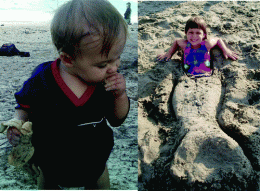New insights into when beach sand may become unsafe for digging and other contact

On warm days, the beach seems an ideal destination for family rest and relaxation. Who hasn't built a sand castle or been buried up to the neck in sand? However, that family fun has a dark side -- sand can harbor illness-causing microbes. Unfortunately, there are no guidelines for sand quality at recreational sites.
Now, environmental scientists at the University of Miami (UM) and at Northern Illinois University have created a reference guide for potentially harmful germs in sand, similar to the guidelines set by the US Environmental Protection Agency for marine water. The report is published in the American Chemical Society journal Environmental Science & Technology.
"These values can be used by beach managers to make decisions concerning sand quality," says Helena Solo-Gabriele, professor in the Department of Civil, Architectural and Environmental Engineering at the UM College of Engineering and principal investigator of this project. "That way, when regulators are faced with a decision about a potential health risk, there is a guideline available with which to decide whether or not the levels of microbes found in the sand are cause for concern."
Dogs, birds and cats visiting a beach are common sources of bacteria in the sand. "Exposures to high levels of certain microorganisms could cause gastrointestinal illness in humans, while infectious risks vary in different microorganism," says Tomoyuki Shibata, assistant professor in the Public Health Program and Institute for the Study of the Environment, Sustainability, & Energy, at Northern Illinois University and first author of the study.
The researchers wanted to determine what levels of bacteria, or pathogens, found in beach sand could pose a health risk for beachgoers, explains Solo-Gabriele, who is also Co-PI of the Oceans and Human Health Center at the UM Rosenstiel School of Marine and Atmospheric Science (RSMAS).
"The environments in the sand and water are very different," said Solo-Gabriele. "The sand provides more protection against the effects of solar radiation, which has a tendency to inactivate microbes in water. Sand may also protect microbes from predators (other microbes) that are found exclusively in water."
To develop the guidelines, the scientists ran one million simulations of the number of microbes in each gram of sand, the transfer of sand from hand to mouth and the ingestion rate. The researchers determined the risk of having 19 cases per 1,000 beachgoers--the level used by the EPA for swimming in marine recreational waters.
The team also documented the levels of pathogens found in the sand at Hobie Cat Beach, in Miami. The findings indicate that levels of harmful microbes at the beach site were low, when compared to the reference levels and therefore safe for beachgoers.
However, studies have shown that children have a higher illness risk than adults from beach and sand exposures. For that reason, the researchers will now focus on studies of kids' play behavior in sand, to better estimate the acceptable levels of microbes that can cause diseases in children.
"Parents of young children don't need to overreact to our findings and they can reduce their child's infectious risk by basic hygiene practices such as hand washing before eating or drinking and taking a shower," said Shibata.
More information: “Quantitative Microbial Risk Assessment of Human Illness from Exposure to Marine Beach Sand” Environ. Sci. Technol., 2012, 46 (5), pp 2799–2805. DOI: 10.1021/es203638x
Abstract
Currently no U.S. federal guideline is available for assessing risk of illness from sand at recreational sites. The objectives of this study were to compute a reference level guideline for pathogens in beach sand and to compare these reference levels with measurements from a beach impacted by nonpoint sources of contamination. Reference levels were computed using quantitative microbial risk assessment (QMRA) coupled with Monte Carlo simulations. In order to reach an equivalent level of risk of illness as set by the U.S. EPA for marine water exposure (1.9 × 10–2), levels would need to be at least about 10 oocysts/g (about 1 oocyst/g for a pica child) for Cryptosporidium, about 5 MPN/g (about 1 MPN/g for pica) for enterovirus, and less than 106 CFU/g for S. aureus. Pathogen levels measured in sand at a nonpoint source recreational beach were lower than the reference levels. More research is needed in evaluating risk from yeast and helminth exposures as well as in identifying acceptable levels of risk for skin infections associated with sand exposures.
Provided by American Chemical Society












